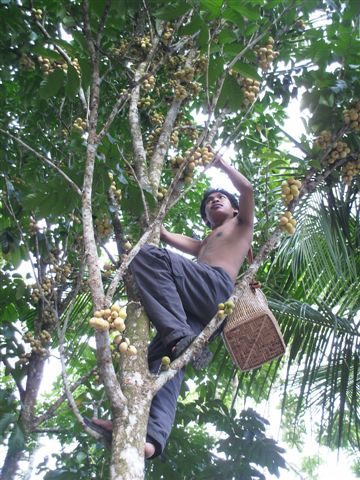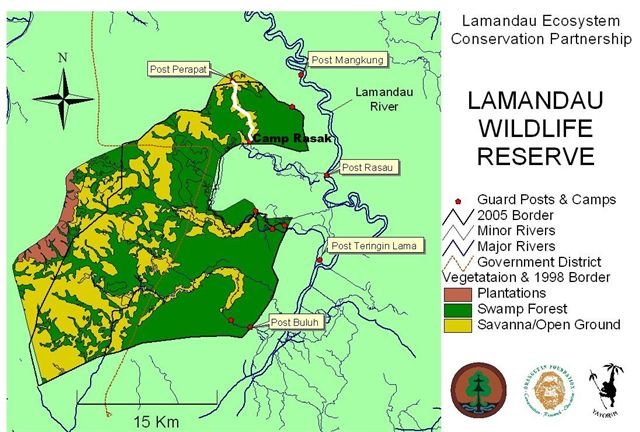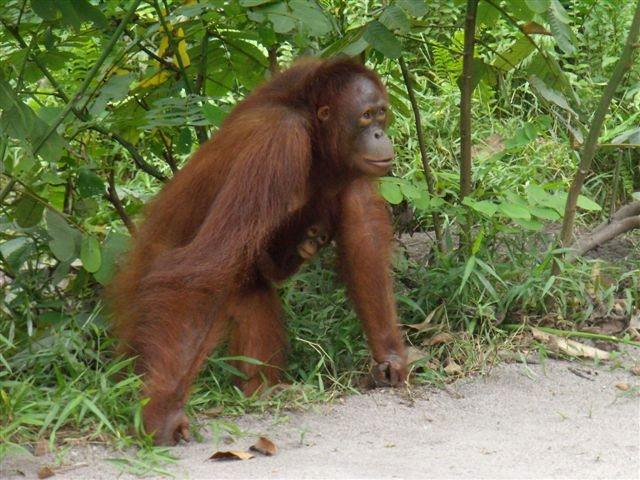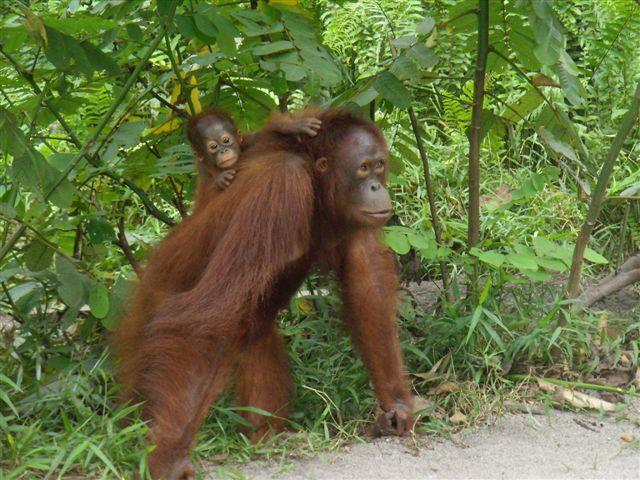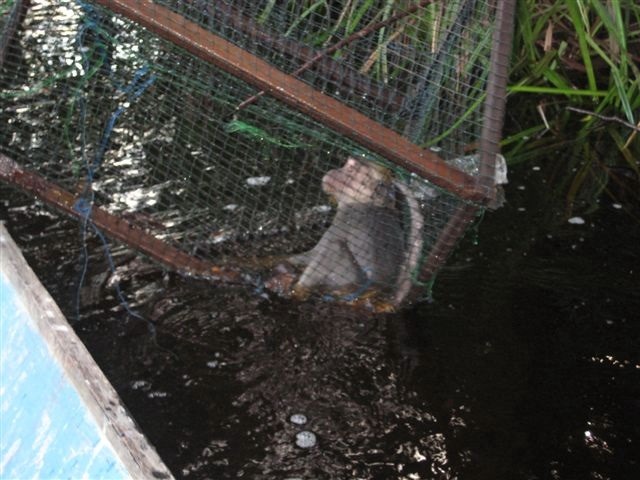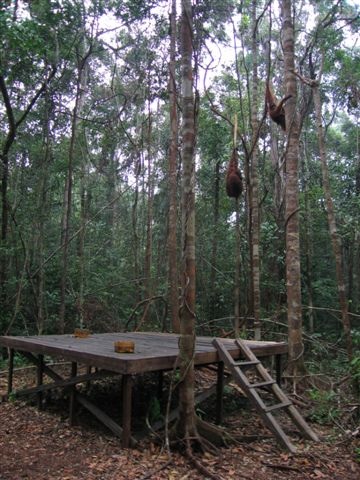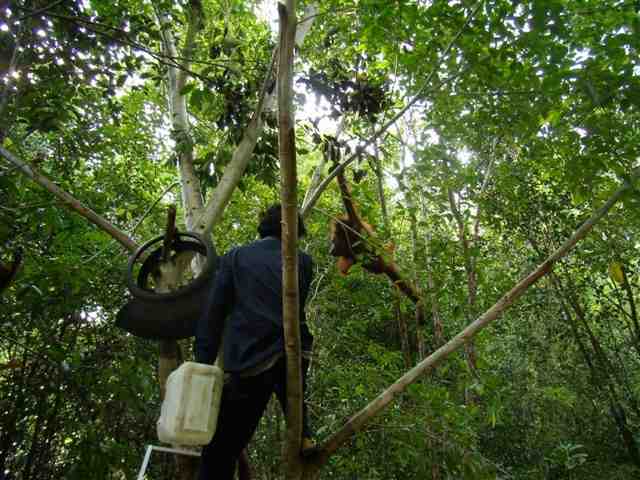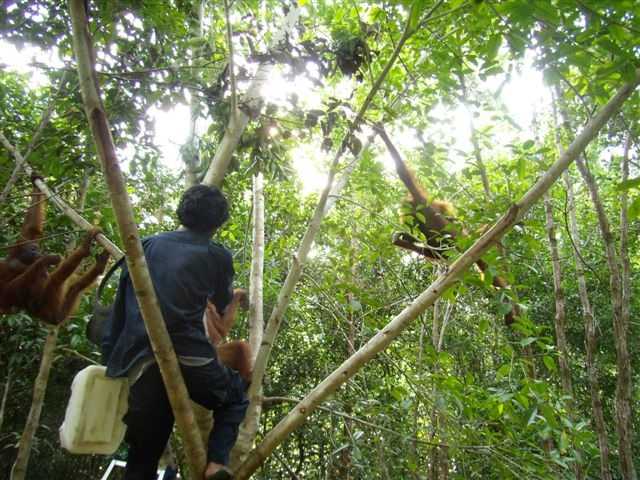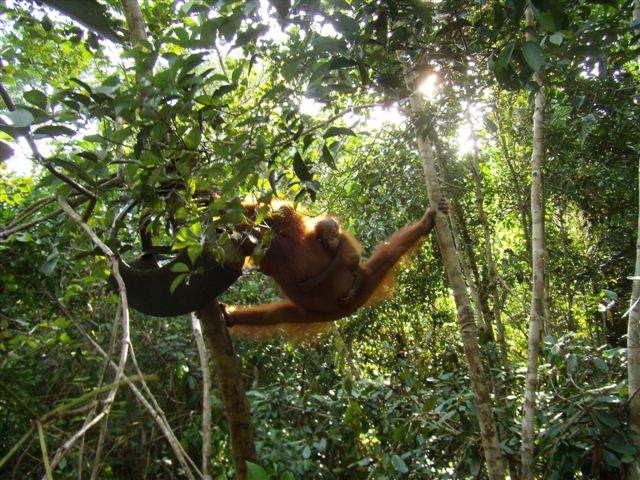It is about time you read a story about orangutans, so here is a great one. Last Sunday, we released two teenage female orangutans back to a life in the wild.
Kath and Jutak came to us as orphans. Both were confiscated from people who were holding them illegally as pets. Kath’s story is particularly tragic. She was confiscated from an animal dealer, in West Kalimantan (the neighbouring province) way back in 1998. She was chained around the neck, where the skin was rubbed raw. She cowered from her “owner” who became very aggressive during the confiscation. Eventually, the Police were called to tell him to back off.
During her time at the Orangutan Care and Quarantine, Kath’s weight increased over three-fold. On Sunday she weighed a healthy 25kg. Unfortunately, Kath was plagued by a persistent cough which prevented her from being released any earlier. The nightmare disease with captive primates is tuberculosis but repeated tests for TB came back negative. However, the cough would not respond to any medication whether homeopathic or western. It is only in the last couple of months her cough has subsided. And as soon as that happened, we thought “time to go!”

Kath and Jutak in the pick-up
After a final health check by the vets, the two orangutans were carried over to the travel cages, which were then loaded on to the back of the Forestry Department’s pick-up. (I laughed when I saw a little orangutan in one of the neighbouring enclosures standing on tip-toes trying to see what was going on). At this point, Kath and Jutak were OK, but their adrenaline must have been starting to flow. After the twenty minute drive to the jetty they looked decidedly nervous. When we tried to move their cages into the waiting speedboats, it became all too much. The orangutans tried to grab onto whatever they could to stop themselves from being lifted. Their fingers were gently prised open and the cages lowered into the boats.

As quickly as possible the boats took off and the two orangutans seemed to settle down, watching the river bank drift past. Kath even drank some water and ate an orange, which a truly scared orangutan would never do. A Brahminy kite circled overhead and twice hornbills flew across the river in front of us. Once we turned off the main Lamandau River into the Rasau River, a smaller, black-water tributary, the boats had to slow down, and the orangutans became positively curious. No doubt they were smelling the forest.

Once at Camp Rasak, far upstream, their cages were lifted onto a well barrow and trundled into the surrounding forest. Each Camp has a feeding site, which is also where orangutans are released so they know straight away where they can find food. The aim of rehabilitation is to return orangutans back to a life in the wild. The food they are given each day is only a supplement. It does not meet their full dietary requirement, so the orangutans still have to forage, but it does gives them some stability has they adapt to life in the forest.

Release site feeding platform
In the OCCQ, the orangutans sleep inside at night. In Lamandau, they have to make a new nest each day. At the OCCQ, the older orangutans are only taken to the nursery forest every second day – so we can separate males and females to stop unwanted pregnancies (we are happy if they breed in the forest, but we don’t want any more babies in cages). In Lamandau, the orangutans will be climbing and moving all day, every day. It takes the orangutans some time in their new surroundings to find the food trees, and to work out where the previously released orangutans’ home ranges are. For all these reasons the feeding sites are useful on top of which they allow our field assistants to monitor daily who is around, whether they are in a good physical condition.

In the wild again!!!
On Sunday, at the feeding site, Kath and Jutak climbed out as soon as their cage door swung open. But their excitement was not yet over. Straight away they were faced by Janu, a rather rambunctious teenage male. His thoughts were not on the mangoes laid out on the feeding platform, but on the two nubile females just arrived. He tried to inspect Kath who challenged him and slipped out of his grasp. There is no way a female orangutan can physically resist a sub-adult, let alone a fully adult male, but Kath had a plan. As she ducked out of the way, she exposed Jutak who Janu grabbed and held down with ease.

Curious Janu
I actually felt very sorry for Jutak. After having been loaded into a travel cage, driven in a car, put in a speedboat, and finally wheeled on a wheelbarrow, both her and Kath must have been, at the very least, bewildered. To be then grabbed and held down by a male of whose size she had never encountered, must have been the final straw. Jutak whimpered as Janu held her. The Assistants closed in to make sure he did not bite her, but nothing aggressive happened. Janu poked prodded and sniffed but then let her go. Jutak dashed up a tree and climbed hurriedly away. Kath, by this time had moved some off some 30m and was watching from high up in a tree.
We left them at sunset as both orangutans made their first nests in their new home. Two assistants will follow the orangutans for a week, recording how far they travel, what they eat and where they sleep. This way we can make sure they are settling in OK.
Despite the adventures of the day, it looked as if both will do just fine. We’ll keep you updated on their progress.


